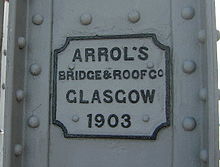Connel Bridge
Coordinates: 56 ° 27 ′ 23 " N , 5 ° 23 ′ 30" W.
| Connel Bridge | ||
|---|---|---|
| use | Road traffic , earlier also railroad | |
| Convicted | A828 | |
| place | Connel and North Connel , Argyll and Bute | |
| construction | Tannery | |
| Longest span | 152.5 m | |
| Clear height | 15 m | |
| building-costs | £ 43,000 | |
| start of building | 1901 | |
| completion | May 9, 1903 | |
| planner | John Wolfe Barry | |
| location | ||
|
|
||
Connel Bridge , also Connel Ferry Bridge , is a tannery bridge at the mouth of Loch Etive in Scotland . It runs the A828 from Connel via the Falls of Lora to North Connel . When completed, Connel Bridge was the second longest span bridge in the United Kingdom after the Forth Bridge .
construction
The bridge has a span of 152.5 m. The roadway is 15 m above the water level. Brick fore bridges with three arches each create a connection to the land on both sides.
The bridge was built by the company Sir William Arrol & Co. from Glasgow and completed on May 9, 1903. Almost 2,600 tons of steel were used for the construction. The construction cost was nearly £ 43,000 .
Railway and road bridge
Originally the bridge was a single-lane railway bridge . It served the branch line to Ballachulish of the Callander and Oban Railway , which opened on August 20, 1903. In 1909 another connection was added between the ferry from Connel and Benderloch . On it, road vehicles could be transported over the bridge in both directions. The vehicles were each loaded one by one onto a Kremser that had been adapted for rail operation by the St. Rollox railway works from Glasgow .
In 1914 a road was led across the bridge parallel to the railway line. The road ran on the west side and the rails on the east side. Because of the close proximity, rail and road vehicles were not allowed to cross the bridge at the same time. Gates at both ends regulated access. The road users had to pay a bridge toll.
In 1966 the railway line was taken out of service. The bridge was converted into a pure road bridge and the toll was abolished. The bridge is still too narrow for two-way traffic. Traffic lights at both ends regulate access these days.
The steel girders were rammed several times by high trucks above the passageways at both ends. Thereupon the passages were increased. Today the maximum headroom is 4.2 m.
Movie
A scene in the film Die Nadel takes place on the bridge . The German agent Heinrich Faber, played by Donald Sutherland , drives over the bridge on a stolen motorcycle. When he runs out of gas on the way, he pushes the motorcycle down the embankment on the north side of the bridge.
Web links
Individual evidence
- ↑ a b Entry on Connel Bridge in Canmore, the database of Historic Environment Scotland (English)
- ^ A b Charles Fryer: The Callander and Oban Railway . Oxford 1989, Oakwood Press. ISBN 0-8536-1377-X . P. 167
- ^ John Thomas: The Callander and Oban Railway. Newton Abbot , 1966. David and Charles. P. 131


